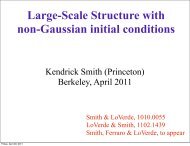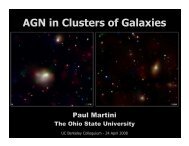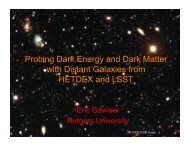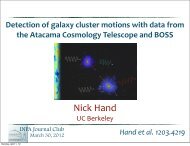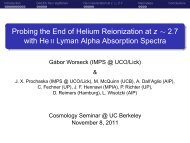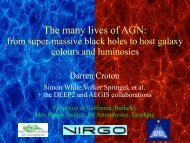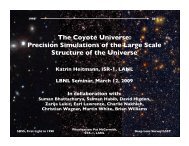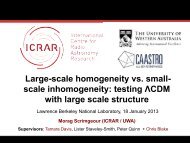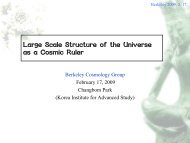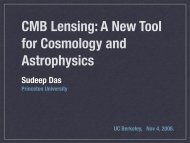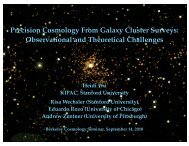WiggleZ Dark Energy Survey (almost) Final Results
WiggleZ Dark Energy Survey (almost) Final Results
WiggleZ Dark Energy Survey (almost) Final Results
Create successful ePaper yourself
Turn your PDF publications into a flip-book with our unique Google optimized e-Paper software.
<strong>WiggleZ</strong> <strong>Dark</strong> <strong>Energy</strong> <strong>Survey</strong><br />
(<strong>almost</strong>) <strong>Final</strong> <strong>Results</strong><br />
Tamara Davis<br />
University of Queensland<br />
and the whole <strong>WiggleZ</strong> team:<br />
UQ: Michael Drinkwater, Tamara Davis, David Parkinson, Signe Riemer-‐Sorensen, Russell Jurek (now at ATNF)<br />
Swinburne: Warrick Couch, Chris Blake, Karl Glazebrook, Greg Poole, Darren Croton, Eyal Kazin, Felipe Marin<br />
AAO: MaGhew Colless, Rob Sharp, Sarah Brough; Sydney: ScoG Croom, Ben Jellife; ANU: Mike Pracy;<br />
UBC: David Woods; Caltech: Chris MarQn, Ted Wyder; Carnegie: Barry Madore<br />
Plus students, associate members, and frequent collaborators, including Morag Scrimgeour and Florian Beutler
The prize
ON THE WAGER BETWEEN SEAN CARROLL AND BRIAN SCHMIDT<br />
We hereby proclaim a wager made between Sean Carroll and Brian Schmidt.<br />
The Winner shall, in August 2011, receive the bottle of port purchased by the<br />
two forementioned people and kept by John Huchra.<br />
Whereas Mr. Carroll sayeth that the value of Ω 0 , the density parameter of<br />
the Universe, will be viewed by the consensus of astronomers as being known<br />
to an accuracy of ±0.3 on August 1, 2011.<br />
Whereas Mr. Schmidt sayeth that the value of Ω 0 , the density parameter of<br />
the Universe, will be viewed by the consensus of astronomers as not being<br />
known to an accuracy of ±0.3 on August 1, 2011.<br />
The tern “consensus” will be agreed upon by Mr. Carroll and Mr. Schmidt.<br />
If these two cannot come to terms on this point, it then shall be decided by<br />
Mr. Huchra<br />
Witnessed this 1 st day of August in the year of our Lord 1991.
Many types of observations = concordance<br />
Nucleosynthesis<br />
Sound<br />
Hinshaw horizon et al. 2013,<br />
Nine-‐year scale WMAP<br />
Power spectrum<br />
of fluctuations<br />
D A (z), H(z)<br />
Growth<br />
Peculiar<br />
velocities<br />
Image: Sam Moorfield, Swinburne<br />
D L (z)<br />
1.5%<br />
1.6%<br />
3.7%
Overview<br />
Distances using BAO<br />
Paper 1: z = 0.6<br />
Paper 2: z=0.44, 0.6, 0.73<br />
Growth at high-z<br />
H(z) using Alcock-<br />
Paczynski<br />
Paper 1: +SNe<br />
Paper 2: +BAO<br />
What is <strong>WiggleZ</strong>?<br />
Cosmology <strong>Results</strong> I’ll talk about <strong>Results</strong> I’ll skip<br />
Homogeneity<br />
Neutrinos<br />
Paper 1: mass<br />
Paper 2: N eff<br />
Full P(k) analysis<br />
Data Release<br />
CosmoMC<br />
2D BAO<br />
Reconstruction<br />
Non-Gaussianity<br />
with Higher-order<br />
clustering<br />
Genus/Topology<br />
Non-standard<br />
cosmologies<br />
Variations in G
<strong>WiggleZ</strong>, main cosmology papers:<br />
Paper Lead authors Title: “The <strong>WiggleZ</strong> <strong>Dark</strong> <strong>Energy</strong> <strong>Survey</strong>:” arXiv<br />
BAO’s at z=0.6 Blake, Davis, Poole, Parkinson et al.,<br />
2011<br />
BAO’s in 3 redshia bins Blake, Kazin, Beutler, Davis,<br />
Parkinson, et al. 2011<br />
tesQng the cosmological model with baryon<br />
acousQc oscillaQons at z= 0.6<br />
mapping the distance-‐redshia relaQon with<br />
baryon acousQc oscillaQons<br />
Growth in 4 redshia bins Blake, et al. 2011 the growth rate of cosmic structure since<br />
redshia z=0.9<br />
Alcock-‐Paczynscki + SNe Blake, Glazebrook, Davis, et al. 2011 measuring the cosmic expansion history using<br />
the Alcock-‐Paczynski test & distant Se<br />
Alcock-‐Paczynscki + BAO Blake, et al. 2012 joint measurements of the expansion and<br />
growth history at z < 1<br />
Homogeneity Scrimgeour, Davis, Blake, James,<br />
Poole, Staveley-‐Smith et al. 2012<br />
Neutrino mass Riemer-‐Sørensen, Blake, Parkinson,<br />
Davis, et al. 2012<br />
Data release and full<br />
cosmological analysis<br />
Parkinson, Riemer-‐Sørensen, Blake,<br />
Poole, Davis et al. 2012<br />
1105.2862<br />
1108.2635<br />
1104.2948<br />
1108.2637<br />
1204.3674<br />
the transiQon to large-‐scale cosmic homogeneity 1205.6812<br />
Cosmological neutrino mass constraint from<br />
blue high-‐redshia galaxies<br />
1112.4940<br />
<strong>Final</strong> data release and cosmological results 1210.2130<br />
Turnover in power spect. Poole, Blake, Parkinson, et al. 2012 Probing the epoch of radiaQon dominaQon using<br />
large scale structure<br />
<strong>WiggleZ</strong> extensions<br />
Varying constants Nesseris, Blake, Davis, Parkinson<br />
2011<br />
Number of neutrinos Riemer-‐Sørensen, Parkinson, Davis,<br />
Blake 2012<br />
Constraining the evoluQon of Newton’s constant<br />
using the growth rate of structure<br />
Simultaneous constraints on the number and<br />
mass of relaQvisQc species<br />
1211.5605<br />
1107.3659<br />
1210.2131<br />
Chris Blake
<strong>WiggleZ</strong> survey fields<br />
(compared to other AAT surveys)<br />
7 equatorial fields, each 100-200 deg 2<br />
>9° on side, ~3 x BAO scale at z > 0.5<br />
Physical size ~ 1300 x 500 x 500 Mpc/h
Understanding our survey<br />
z=1.0<br />
z=0.2<br />
Redshift distribution
Understanding our survey<br />
z=1.0<br />
z=0.2
<strong>WiggleZ</strong> regions
Understanding our survey<br />
z=1.0<br />
z=0.2<br />
Probability of finding two<br />
galaxies at separaQon, r<br />
Excess likelihood<br />
of finding two<br />
galaxies at<br />
separation r<br />
Landy-Szalay<br />
estimator (1993)
Blake, Davis, Poole, Parkinson et al. 2011<br />
Blake, Kazin, Beutler, Davis, Parkinson et al. 2011<br />
1. BARYON ACOUSTIC<br />
OSCILLATIONS
CorrelaQon<br />
BAO-1: Single redshift bin<br />
Correlation Function<br />
Blake, Davis, Poole,<br />
Parkinson et al. 2011<br />
SeparaQon<br />
Power spectrum<br />
Blake, Davis, Poole,<br />
Parkinson et al. 2011<br />
BOSS
Measuring the distance scale<br />
BAO<br />
CMB<br />
Two TangenQal One Radial
BAO-2: Three redshift bins<br />
Blake, Kazin, Beutler, Davis,<br />
Parkinson et al. 2011
<strong>WiggleZ</strong> – Baryon Acoustic Oscillations<br />
Compared to supernovae<br />
6dFGS<br />
SDSS<br />
BOSS<br />
<strong>WiggleZ</strong><br />
Blake, Kazin, Beutler,<br />
Davis, Parkinson et al. 2011<br />
No longer need SNe!<br />
BAO distances alone now<br />
require acceleraQon!<br />
BAO Each and probe SNe Combined individually with CMB<br />
BOSS
<strong>WiggleZ</strong> – Baryon Acoustic Oscillations<br />
Compared to supernovae<br />
6dFGS<br />
SDSS<br />
BOSS<br />
<strong>WiggleZ</strong><br />
Blake, Kazin, Beutler,<br />
Davis, Parkinson et al. Chris 2011 Blake<br />
We don’t know what is causing<br />
the acceleration<br />
(And the leading candidate,<br />
vacuum energy, is 10 120 too large)<br />
No longer need SNe!<br />
BAO distances alone now<br />
require acceleraQon!<br />
BAO Each and probe SNe Combined individually with CMB
Curvature<br />
Varying eqn of state<br />
<strong>Final</strong> combined results
Many ways to use BAO
Some models<br />
can’t be distinguished<br />
using only distance data<br />
Davis et al. 2007<br />
Cardassian<br />
ΛCDM<br />
General Chaplygin<br />
ΛCDM
Other types of measurements needed<br />
• Growth<br />
f = ~ Ω M (z) γ<br />
γ is different in different models<br />
• Amplitude of density fluctuations at present day<br />
σ 8<br />
1. measure density in spheres 8 Mpc in radius<br />
2. calculate the dispersion<br />
overdensity<br />
γ = 6/11 in ΛCDM<br />
γ = 6/10 in CDM<br />
γ = 11/16 in DGP
Blake et al. 2011<br />
2. GROWTH OF STRUCTURE
<strong>WiggleZ</strong> – Growth of Structure<br />
Blake et al. 2011<br />
Blake et al. 2011<br />
BOSS<br />
(Reid+ 2012)<br />
(Parkinson et al. in prep)
Blake, Glazebrook, Davis et al. 2011<br />
3A. H(Z) ALCOCK-PACZYNSKI<br />
+ SN
BAO – a standard sphere<br />
• SNe = radial info (line of sight)<br />
• CMB = tangential info (surface of sphere)<br />
• BAO can be applied radially to give H(z) AND<br />
tangentially to give D A (z)<br />
Alcock-Paczynski test:<br />
H(z)<br />
D A (z)<br />
✓<br />
H(z)<br />
D A (z)
Alcock-Paczynski / z-space distortions<br />
H fid /H<br />
Blake et al. 2011 (AP)<br />
Blake, Glazebrook,<br />
Davis et al. 2011 (AP)<br />
D A /D A,fid<br />
Ballinger et al. 1996
<strong>WiggleZ</strong> – Measurement of H(z)<br />
<strong>WiggleZ</strong> measures<br />
Supernovae measure<br />
Distances are related by<br />
So the ratio gives<br />
Blake, Glazebrook, Davis Blake et al. et2011 al. 2011 (AP)<br />
(AP)
Blake et al. 2012<br />
3B. H(Z) ALCOCK-PACZYNSKI<br />
+ BAO
<strong>WiggleZ</strong> growth + AP + BAO<br />
<strong>WiggleZ</strong> AP measures<br />
<strong>WiggleZ</strong> BAO measures<br />
So the combination<br />
allows us to measure<br />
distance and<br />
expansion rate<br />
separately<br />
Marginalized over Ω m h 2 , with CMB prior<br />
(Komatsu et al. 2009) of 0.1345±0.0055
Covariances<br />
400<br />
lognormal<br />
realizations<br />
per <strong>WiggleZ</strong><br />
field and<br />
per z-slice<br />
(7200 total)
Combined with other BAO, SNe, and Ω m h 2<br />
<strong>WiggleZ</strong> and BOSS (AP+BAO)<br />
6dFGS and SDSS BAO<br />
SNe (Union)<br />
WMAP Ω m h 2 (not distances)<br />
No AP data<br />
Ω m =0.27, h=0.71
Riemer-Sørensen, Blake, Parkinson, Davis, et al. 2012<br />
Riemer-Sørensen, Parkinson, Davis, Blake, et al. 2013<br />
Riemer-Sørensen, Parkinson, Davis 2013<br />
4. NEUTRINO MASS AND N EFF
<strong>WiggleZ</strong>: Neutrino mass<br />
Heavy neutrinos =<br />
strong suppression over<br />
short range<br />
Light neutrinos =<br />
weak suppression over<br />
long range<br />
h=0.742±0.036<br />
Reiss et al. 09<br />
Relative probability<br />
0.25<br />
0.20<br />
0.15<br />
0.10<br />
0.05<br />
Ω ν<br />
P PGiggleZ(k)/P GiggleZ(k)/Plin(k) lin(k)<br />
1.4<br />
1.3<br />
1.2<br />
1.1<br />
1.0<br />
0.9<br />
0.8<br />
<strong>WiggleZ</strong>+H 0 +BAO+WMAP<br />
Σm υ < 0.29eV<br />
<strong>WiggleZ</strong>+WMAP<br />
Σm υ < 0.60eV<br />
Non-‐lineariQes less severe for <strong>WiggleZ</strong><br />
Massive highly<br />
biased galaxies<br />
at z = 0.2<br />
0.00<br />
0.0 0.2 0.4 0.6 0.8<br />
m [eV]<br />
1.0 1.2 1.4<br />
Riemer-‐Sørensen et al. 2012<br />
<strong>WiggleZ</strong> galaxies<br />
at z = 0.2<br />
<strong>WiggleZ</strong> galaxies<br />
at z = 0.6<br />
0.1 0.2 0.3 0.4 0.5<br />
k [h Mpc -1 0.1 0.2 0.3 0.4 0.5<br />
k [h Mpc ]<br />
-1 ]<br />
WMAP<br />
Σm υ < 1.3eV<br />
SDSS (Reid et al. 10)<br />
Σm υ < 0.62eV<br />
Photo (dePuGer 12)<br />
Σm υ < 0.28eV<br />
Ly-‐α (Seljak et al. 06)<br />
Σm υ < 0.17eV<br />
To k=0.3;<br />
To k=0.1 we get<br />
Σm υ < 0.39eV
Paper 2: Neutrino mass + number
Simultaneous constraints on N eff & m ν
Scrimgeour, Davis, Blake et al. 2012<br />
5. HOMOGENEITY
Fractal dimension (Morag Scrimgeour, ICRAR)
Fractal models
Parkinson, Riemer-Sørensen, Blake, Poole, Davis, et al. 2012<br />
6. FULL POWER SPECTRUM<br />
DATA RELEASE + COSMOMC
Full analysis, Data, and CosmoMC<br />
hGp://www.smp.uq.edu.au/wigglez-‐data
<strong>Final</strong> results
<strong>Final</strong> results<br />
(ΛCDM wins)
Poole, Blake, Parkinson, et al. 2013<br />
7. TURNOVER
Turnover in the Power Spectrum<br />
Poole et al. 2012<br />
z eff = 0.62
<strong>WiggleZ</strong> and Friends….<br />
8. FUTURE
Q()<br />
Q()<br />
Q()<br />
Q()<br />
Q()<br />
2<br />
1.5<br />
1<br />
0.5<br />
0<br />
2<br />
1<br />
0<br />
4<br />
3<br />
2<br />
1<br />
0<br />
1<br />
10<br />
5<br />
0<br />
5<br />
40<br />
20<br />
0<br />
20<br />
Other Upcoming <strong>Results</strong> (with WigglerZ at this conference)<br />
Higher-order statistics<br />
(see Felipe Marin)<br />
s 1 :s 2 =7:7 h 1 Mpc s 1 :s 2 =7:14 h 1 Mpc s 1 :s 2 =7:21 h 1 Mpc<br />
s 1 :s 2 =10:10 h 1 Mpc s 1 :s 2 =10:20 h 1 Mpc s 1 :s 2 =10:30 h 1 Mpc<br />
s 1 :s 2 =15:15 h 1 Mpc s 1 :s 2 =15:30 h 1 Mpc s 1 :s 2 =15:45 h 1 Mpc<br />
s 1 :s 2 =20:20 h 1 Mpc s 1 :s 2 =20:40 h 1 Mpc s 1 :s 2 =20:60 h 1 Mpc<br />
s 1 :s 2 =30:30 h 1 Mpc<br />
0 30 60 90 120 150<br />
(degrees)<br />
s 1 :s 2 =30:60 h 1 Mpc<br />
0 30 60 90 120 150<br />
(degrees)<br />
s 1 :s 2 =30:90 h 1 Mpc<br />
Marin<br />
0 30 60 90 120 150<br />
(degrees)<br />
2D BAO and reconstruction<br />
(see Eyal Kazin)<br />
Davis
Topology: Genus curve<br />
Test whether quantum<br />
fluctuaQons are the seeds of<br />
structure<br />
dimensionless genus g (ν )<br />
0.15<br />
0.1<br />
0.05<br />
0<br />
−0.05<br />
Smoothing =<br />
10Mpc<br />
(non-‐linear)<br />
Berian James<br />
Gaussian<br />
random<br />
field<br />
(dashed)<br />
−0.1<br />
−4<br />
Smoothing = 30Mpc<br />
(more linear)<br />
−2 0 2 4<br />
density parameter ν
Future – OzDES?
Future – Quasars give distances??<br />
AGN as Standard<br />
Candles<br />
(Watson, Denney,<br />
Vestergaard & Davis 2011)
Fire…
But all is well.<br />
Ángel R. López-‐Sánchez
Summary<br />
<strong>WiggleZ</strong> is a great data set, with many interesting<br />
cosmology results<br />
We’ve released our data and CosmoMC module<br />
We hope you would like to use it and are happy<br />
to work with you to help
<strong>WiggleZ</strong>, main cosmology papers:<br />
Paper Lead authors Title: “The <strong>WiggleZ</strong> <strong>Dark</strong> <strong>Energy</strong> <strong>Survey</strong>:” arXiv<br />
BAO’s at z=0.6 Blake, Davis, Poole, Parkinson et al.,<br />
2011<br />
BAO’s in 3 redshia bins Blake, Kazin, Beutler, Davis,<br />
Parkinson, et al. 2011<br />
tesQng the cosmological model with baryon<br />
acousQc oscillaQons at z= 0.6<br />
mapping the distance-‐redshia relaQon with<br />
baryon acousQc oscillaQons<br />
Growth in 4 redshia bins Blake, et al. 2011 the growth rate of cosmic structure since<br />
redshia z=0.9<br />
Alcock-‐Paczynscki + SNe Blake, Glazebrook, Davis, et al. 2011 measuring the cosmic expansion history using<br />
the Alcock-‐Paczynski test & distant Se<br />
Alcock-‐Paczynscki + BAO Blake, et al. 2012 joint measurements of the expansion and<br />
growth history at z < 1<br />
Homogeneity Scrimgeour, Davis, Blake, James,<br />
Poole, Staveley-‐Smith et al. 2012<br />
Neutrino mass Riemer-‐Sørensen, Blake, Parkinson,<br />
Davis, et al. 2012<br />
Data release and full<br />
cosmological analysis<br />
Parkinson, Riemer-‐Sørensen, Blake,<br />
Poole, Davis et al. 2012<br />
1105.2862<br />
1108.2635<br />
1104.2948<br />
1108.2637<br />
1204.3674<br />
the transiQon to large-‐scale cosmic homogeneity 1205.6812<br />
Cosmological neutrino mass constraint from<br />
blue high-‐redshia galaxies<br />
1112.4940<br />
<strong>Final</strong> data release and cosmological results 1210.2130<br />
Turnover in power spect. Poole, Blake, Parkinson, et al. 2012 Probing the epoch of radiaQon dominaQon using<br />
large scale structure<br />
<strong>WiggleZ</strong> extensions<br />
Varying constants Nesseris, Blake, Davis, Parkinson<br />
2011<br />
Number of neutrinos Riemer-‐Sørensen, Parkinson, Davis,<br />
Blake 2012<br />
Constraining the evoluQon of Newton’s constant<br />
using the growth rate of structure<br />
Simultaneous constraints on the number and<br />
mass of relaQvisQc species<br />
1211.5605<br />
1107.3659<br />
1210.2131
Australian fires from space<br />
Chris Hadfield (ISS)
A. EXTRA SLIDES
<strong>WiggleZ</strong> cosmology fits – paper 1<br />
Blake, Davis, et al. 2011
BAO distance ratio only – paper 1
<strong>Final</strong> <strong>WiggleZ</strong> BAO results
Growth of Structure<br />
Image: Chris Blake
Growth of Structure – <strong>WiggleZ</strong> final result<br />
Blake et al. 2011 (Growth)<br />
PloGed vs cos(angle)
Growth vs model<br />
Blake et al. 2011 (Growth)
AP effect
Reconstructions<br />
Blake, Glazebrook,<br />
Davis et al. 2011 (AP)
Covariance matrix – (2 nd AP paper)
Homogeneity - Dependence on bias
Neutrinos - Degeneracies
<strong>WiggleZ</strong>, other papers<br />
Paper Lead authors Title: “The <strong>WiggleZ</strong> <strong>Dark</strong> <strong>Energy</strong> <strong>Survey</strong>:” arXiv<br />
Small-‐scale clustering Blake, Jurek, et al. 2009 small-‐scale clustering of Lyman-‐break galaxies at<br />
z < 1<br />
0901.2587<br />
<strong>WiggleZ</strong> overview Drinkwater, ++ et al. 2010 survey design and first data release 0911.4246<br />
Blue galaxy intrinsic<br />
alignments<br />
Mandelbum et al. 2011 direct constraints on blue galaxy intrinsic<br />
alignments at intermediate redshias<br />
SelecQon funcQon Blake et al. 2011 the selecQon funcQon and z = 0.6 galaxy power<br />
spectrum<br />
KinemaQcs of luminous<br />
star-‐forming galaxies<br />
Wisnioski, Glazebrook, Blake, Wyder,<br />
MarQn, Poole, Sharp, Couch,<br />
Kacprzak, et al.<br />
high-‐resoluQon kinemaQcs of luminous star-‐<br />
forming galaxies<br />
Galaxy evoluQon Li, Yee, et al. 2012 Galaxy EvoluQon at 0.25 < z < 0.75 Using the<br />
Second Red-‐Sequence Cluster <strong>Survey</strong><br />
In preparaSon Nominal lead authors<br />
BAO theory Davis, Beutler, Blake, Parkinson, Scrimgeour et al.<br />
2D BAO’s Davis, Kazin, Blake, et al.<br />
Higher-‐order correlaQons Marin et al.<br />
Growth – beyond standard cosmologies Parkinson et al.<br />
Distances – beyond standard cosmologies Peet, Davis, et al.<br />
ReconstrucQon Kazin et al.<br />
0911.5347<br />
1003.5721<br />
1107.3338<br />
1201.1013




